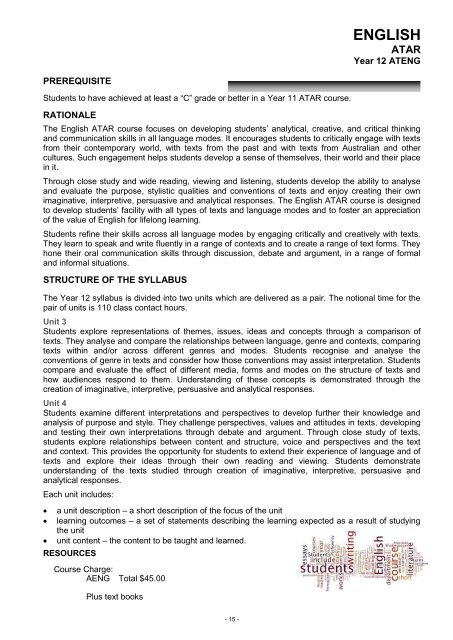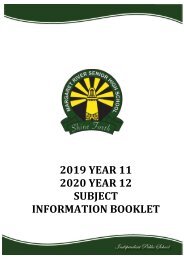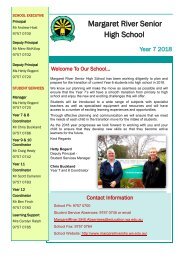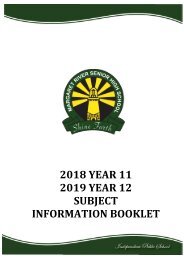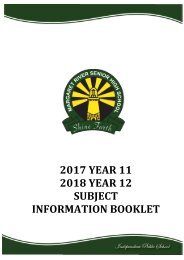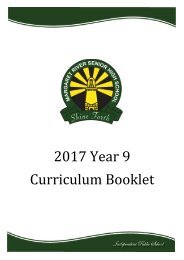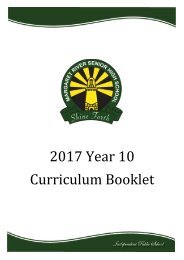2017 Upperschool Course Information
You also want an ePaper? Increase the reach of your titles
YUMPU automatically turns print PDFs into web optimized ePapers that Google loves.
ENGLISH<br />
ATAR<br />
Year 12 ATENG<br />
PREREQUISITE<br />
Students to have achieved at least a ―C‖ grade or better in a Year 11 ATAR course.<br />
RATIONALE<br />
The English ATAR course focuses on developing students‘ analytical, creative, and critical thinking<br />
and communication skills in all language modes. It encourages students to critically engage with texts<br />
from their contemporary world, with texts from the past and with texts from Australian and other<br />
cultures. Such engagement helps students develop a sense of themselves, their world and their place<br />
in it.<br />
Through close study and wide reading, viewing and listening, students develop the ability to analyse<br />
and evaluate the purpose, stylistic qualities and conventions of texts and enjoy creating their own<br />
imaginative, interpretive, persuasive and analytical responses. The English ATAR course is designed<br />
to develop students‘ facility with all types of texts and language modes and to foster an appreciation<br />
of the value of English for lifelong learning.<br />
Students refine their skills across all language modes by engaging critically and creatively with texts.<br />
They learn to speak and write fluently in a range of contexts and to create a range of text forms. They<br />
hone their oral communication skills through discussion, debate and argument, in a range of formal<br />
and informal situations.<br />
STRUCTURE OF THE SYLLABUS<br />
The Year 12 syllabus is divided into two units which are delivered as a pair. The notional time for the<br />
pair of units is 110 class contact hours.<br />
Unit 3<br />
Students explore representations of themes, issues, ideas and concepts through a comparison of<br />
texts. They analyse and compare the relationships between language, genre and contexts, comparing<br />
texts within and/or across different genres and modes. Students recognise and analyse the<br />
conventions of genre in texts and consider how those conventions may assist interpretation. Students<br />
compare and evaluate the effect of different media, forms and modes on the structure of texts and<br />
how audiences respond to them. Understanding of these concepts is demonstrated through the<br />
creation of imaginative, interpretive, persuasive and analytical responses.<br />
Unit 4<br />
Students examine different interpretations and perspectives to develop further their knowledge and<br />
analysis of purpose and style. They challenge perspectives, values and attitudes in texts, developing<br />
and testing their own interpretations through debate and argument. Through close study of texts,<br />
students explore relationships between content and structure, voice and perspectives and the text<br />
and context. This provides the opportunity for students to extend their experience of language and of<br />
texts and explore their ideas through their own reading and viewing. Students demonstrate<br />
understanding of the texts studied through creation of imaginative, interpretive, persuasive and<br />
analytical responses.<br />
Each unit includes:<br />
<br />
<br />
<br />
a unit description – a short description of the focus of the unit<br />
learning outcomes – a set of statements describing the learning expected as a result of studying<br />
the unit<br />
unit content – the content to be taught and learned.<br />
RESOURCES<br />
<strong>Course</strong> Charge:<br />
AENG Total $45.00<br />
Plus text books<br />
- 15 -


